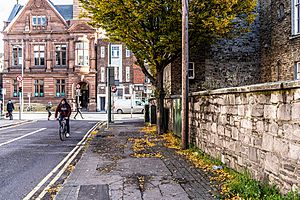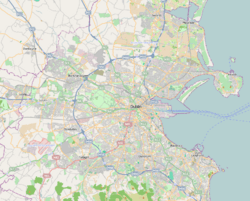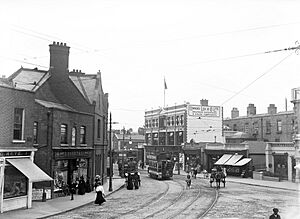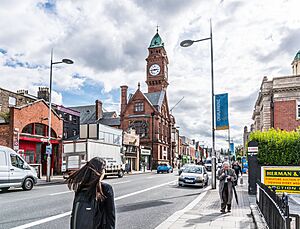Rathmines facts for kids
Quick facts for kids
Rathmines
Ráth Maonais
|
|
|---|---|
|
Inner suburb
|
|

Rathmines Road viewed from Leinster Road
|
|
| Country | Ireland |
| Province | Leinster |
| County | County Dublin |
| Local authority | Dublin City Council |
| Dáil constituency | Dublin Bay South |
| European Parliament | Dublin |
| Elevation | 31 m (102 ft) |
Rathmines is a busy area located on the south side of Dublin, Ireland. It starts at the Grand Canal and stretches south along Rathmines Road. It is next to areas like Rathgar, Ranelagh, and Harold's Cross. Rathmines is part of Dublin's D06 postal district.
For a long time, Rathmines was known as "Flatland." This was because many large old houses were divided into smaller apartments for people moving to Dublin. These included new government workers and students. More recently, many of these historic houses have been turned back into single-family homes. In the 1800s, Rathmines was even called "Dublin Belgravia," which meant it was a fancy and wealthy place.
Contents
What's in a Name?
The name Rathmines comes from the Irish words Ráth Maonais. This means "ringfort of Maonas" or "fort of Maonas." A ringfort was a circular fortified area, often used as a home or a place for trading. The name Maonas might come from an old Irish name or from a Norman family called de Meones. They settled in Dublin around the year 1280.
Like many places nearby, Rathmines grew around a strong, protected structure. These forts were important centers for daily life and business after the Norman invasion of Ireland in the 1100s. Other Dublin areas like Rathgar and Rathfarnham also have names that come from the word "rath."
Rathmines Through Time
Early History
Rathmines has a long history, going back to the 1300s. Back then, Rathmines was part of a large area of church lands called Cuallu. This area later became the big Parish of Cullenswood. There is proof that a settlement around a "rath" existed as early as 1350. Rathmines is also part of the Barony of Uppercross, which was one of the many areas surrounding the old walled city of Dublin.
In the mid-1800s, Rathmines became a popular suburb for wealthy people. They wanted to escape the crowded conditions of Dublin city. A large house, known as Rathmines Old Castle, was built in the 1600s and rebuilt in the 1700s. No part of it remains today.
The Battle of Rathmines
Rathmines is famous for a big battle that happened there in 1649. This was during the Cromwellian conquest of Ireland. The battle, sometimes called the Battle of Baggotrath, took place on August 2, 1649. It led to a major defeat for the Royalist forces in Ireland. Some historians believe this battle was as important as England's Battle of Naseby. It quickly ended the Royalist Siege of Dublin.
The Grand Canal and the Spa
In the early 1790s, the Grand Canal was built along the northern edge of Rathmines. This canal connected Rathmines with Portobello using the La Touch Bridge, which people later called Portobello Bridge.
For hundreds of years, Rathmines was home to a "spa." This was actually a natural spring. People believed its water had healing powers. Many sick people came to the area hoping to get better. In the 1800s, it was called the "Grattan Spa." It was located near Portobello Bridge on land that once belonged to Henry Grattan. Over time, the spa was not looked after well. In 1872, a doctor said the spa was in a "disgraceful state." Later, tests showed the water was not special at all, and the spa was closed.
Important Events in the 1900s
During the Easter Rising on April 25, 1916, a young man named James Joseph Coade was shot and killed on Rathmines Road. This happened while he was attending a church meeting.
The Rathmines Church was used to store weapons during the Irish War of Independence. On January 26, 1920, a fire started at the church. Members of the IRA Dublin Brigade entered the burning church to get the weapons. The fire caused a lot of damage and destroyed the church's dome.
During the Irish Civil War, on December 20, 1922, Séamus Dwyer, a politician, was shot and killed in his shop in Rathmines. Later, in 1933, a Celtic cross was put up to remember Thomas O'Leary, who was found dead nearby.
Rathmines Township
Rathmines became its own local government area, called a Township, in 1847. It later grew to include areas like Rathgar and Ranelagh. The Township was first in charge of things like sanitation. Over time, it gained more powers, like a local council.
Rathmines Town Hall is a very noticeable building in Rathmines. It has a clock tower. The clock is famous for not always showing the correct time on its four faces. Because of this, locals call it the "Four Faced Liar."
In 1930, the Rathmines Township became part of the City of Dublin. Its duties were taken over by Dublin Corporation, which is now called Dublin City Council.
Places to Visit
Cathal Brugha Barracks (also known as Portobello Barracks) is a large army base. It is home to many parts of the Irish Army. Portobello GAA is a local sports club that plays Gaelic football and hurling.
Rathmines Library opened on October 24, 1913. It was built with money from Andrew Carnegie, a famous businessman and philanthropist.
Churches
The green copper dome of Mary Immaculate, Refuge of Sinners Church is a well-known sight. The original dome was destroyed in a fire in 1920. The current dome was put in place when the church reopened in 1922. It was originally meant for a church in St. Petersburg, Russia, but was sent to Dublin instead.
The Holy Trinity Church (Church of Ireland) was designed by John Semple. It was built in the Gothic Revival style and opened in 1828. It is made of a local stone called Black Calp, which turns black in the rain.
Rathmines also has the Grosvenor Road Baptist Church.
Education
Rathmines has several schools. These include St Mary's College and St Louis Primary and St Louis Secondary School. On Upper Rathmines Road, there is a primary school called Kildare Place National School. Rathmines College of Further Education is located in the Town Hall.
Shopping and Entertainment
On September 14, 2014, the old Swan cinema was updated and made much bigger. It now has eight movie screens and shows the latest films, including 3D movies. In October 2017, the Stella Cinema, a classic cinema from the 1980s, was also reopened. It shows both classic and new movies.
Getting Around Rathmines
In the 1850s, horse-drawn buses carried people from Rathmines to the city center. The Portobello Bridge was steep, which was hard for the horses.
On October 6, 1871, work began on the Dublin tram system on Rathmines Road. A horse-drawn tram service started the next year. The Portobello Bridge was also improved around this time.
Rathmines used to have a railway station called Rathmines and Ranelagh. It opened in 1896 and closed in 1959.
Today, Rathmines is served by the Luas light rail system, which is like a tram. The Ranelagh stop is very close to the main street. The Charlemont, Beechwood, and Cowper stops are also within walking distance.
Many Dublin Bus routes also serve Rathmines, including S2, 14, 15, 15A, 15B, 65, 65B, 83, 140, and 142. There are also special night bus services called Nitelink on weekends and holidays.
Notable People
Many interesting people have lived in or are connected to Rathmines:
- Cathal Brugha, an Irish nationalist.
- Nora Connolly O'Brien, an activist and writer, and daughter of James Connolly.
- Andrew Cunningham, 1st Viscount Cunningham of Hyndhope, a British admiral.
- Vincent Dowling, a director in the arts.
- Paddy Finucane, a famous fighter pilot from World War II.
- Grace Gifford, an artist and cartoonist.
- Lafcadio Hearn, a writer known for ghost stories.
- James Joyce, a famous writer, spent part of his childhood here.
- Kathleen Lynn, a politician, activist, and doctor.
- Éamonn MacThomáis, an author, historian, and broadcaster.
- Constance Markievicz, an Irish revolutionary.
- John Mitchel, an Irish nationalist.
- Conor Cruise O'Brien, a writer and politician.
- Brian O'Driscoll, a famous Irish rugby player.
- Walter Osborne, a well-known Irish painter.
- Johnny Sexton, another famous Irish rugby player.
- Francis Sheehy-Skeffington and Hanna Sheehy-Skeffington, both suffragists and activists.
- John Millington Synge, a famous playwright.
Images for kids
See also
 In Spanish: Rathmines para niños
In Spanish: Rathmines para niños











